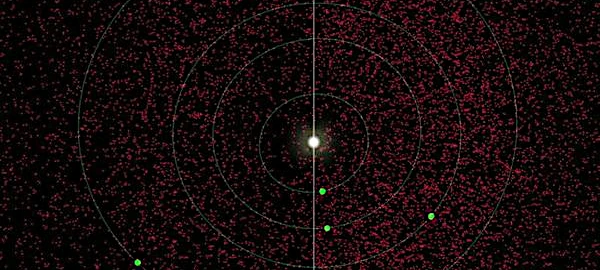
Near-Earth asteroids are celestial bodies whose orbits cross that of Earth. Their number is estimated at over 30,000, but only about 10,000 of them are regularly monitored. Among them, Potentially Hazardous Asteroids (PHA) are those whose minimum intersection distance with Earth (MOID) is less than 0.05 AU, and whose diameter is greater than 140 m. An impact with such an object could release energy greater than 100 megatons of TNT, equivalent to several thousand Hiroshima bombs.
Detection programs such as Pan-STARRS, LINEAR, Catalina Sky Survey, and the European project NEO-MAPP continuously scan the sky to detect objects moving rapidly from a geocentric point of view. The analysis is based on the comparison of successive images, using motion detection algorithms. Once identified, a near-Earth asteroid is observed over several days to refine its orbit using Kepler's equations and gravitational perturbations.
Mapping near-Earth asteroids involves projecting their position in real-time onto the celestial sphere in equatorial coordinates (right ascension $\alpha$, declination $\delta$). Each point corresponds to the apparent position of a given asteroid at a moment $t$, corrected for the parallax effect and atmospheric refraction. The graph evolves continuously with the Earth's rotation and the heliocentric translation of the objects.
Here is a selection of near-Earth asteroids that have grazed Earth or are expected in the coming months, sorted by passage date.
| Asteriod Name | Passage Date | Distance (LD) | Estimated Diameter (m) |
|---|---|---|---|
| 2019 OK | July 25, 2019 | 0.19 | 100 |
| 2020 QG | August 16, 2020 | 0.0003 | 3–6 |
| 2021 SG | September 16, 2021 | 0.05 | 42 |
| 2023 BU | January 26, 2023 | 0.04 | 4–8 |
| 2005 ED224 | September 11, 2023 | 0.015 | 8–15 |
| 2024 DZ2 | March 25, 2024 | 3.5 | 50–110 |
| 2024 MK | June 29, 2024 | 0.36 | 120 |
| 2024 QF2 | July 17, 2024 | 0.92 | 68 |
| 2024 HF5 | August 9, 2024 | 0.11 | 25–40 |
| 2024 JR1 | August 27, 2024 | 0.27 | 70 |
| 2024 SV | September 22, 2024 | 0.08 | 45 |
| 2024 UE1 | October 19, 2024 | 0.05 | 22 |
| 99942 Apophis | April 13, 2029 | 0.10 | 370 |
Note: LD = lunar distance = 384,400 km. A distance of 0.05 LD corresponds to approximately 19,220 km, the altitude of some geostationary satellites.
The fundamental tool is the JPL's SBDB (Small Body Database). From the orbital elements $(a, e, i, \Omega, \omega, M)$, it is possible to calculate the position $(x, y, z)$ of an object in a barycentric reference frame and project it into our night sky.
Objects smaller than 50 m often escape detection, such as the Chelyabinsk meteor (2013), which measured ~20 m. Their low absolute magnitude ($H > 25$) makes detection difficult, except at close approach. Additionally, areas near the Sun (close to zero elongation) are not observable from the ground. Missions such as NEO Surveyor (planned launch) or the Sentinel space observatory will help fill these blind spots.
The dynamics of near-Earth asteroids are chaotic in the long term. Small gravitational perturbations by giant planets can significantly alter their orbits (including the Yarkovsky effect). A dynamic map allows recalculating impact probabilities with each new astrometric measurement. Nominal orbits and trajectory clouds (Monte-Carlo integration) are then compared to Earth's future position.
Monitoring near-Earth asteroids is one of the few scientific fields where every day counts for planetary security. Building a precise and dynamic map of the sky is a physical, mathematical, and technological necessity. It is not the size of the object that makes it dangerous, but our ability to see it coming in time. Mapping the invisible ensures our vigilance in a perpetually moving cosmos.